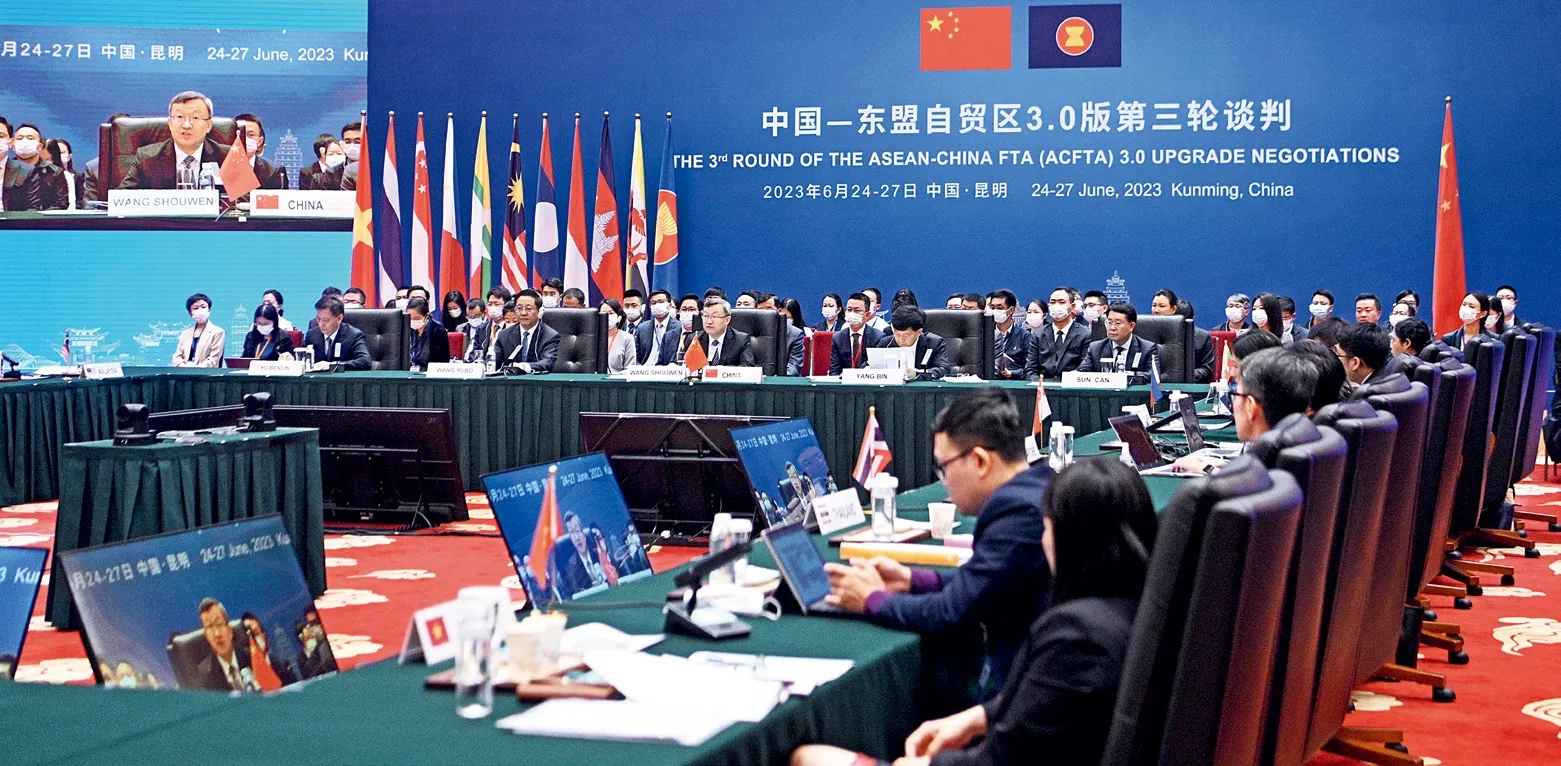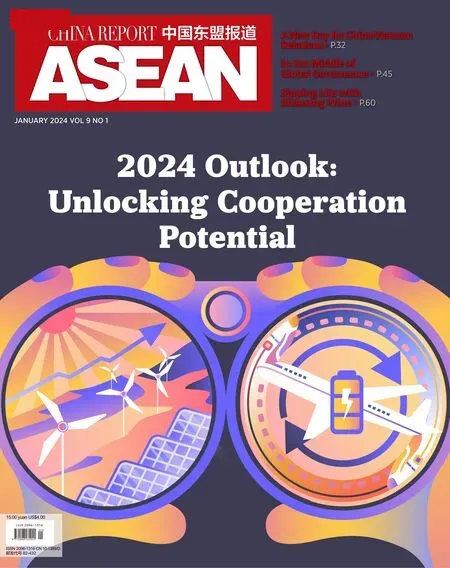Gearing Up For Greater Opportunities
By Guo Xixian
In 2024,ASEAN will continue unlocking market potential and maintaining momentum to achieve greater economic growth

Great Wall Motors officially unveiled an electric vehicle model,the ORA 07,at the 40th Thailand International Motor Expo 2023.An ultra-streamlined new energy coupe,the ORA 07 comes in two versions,long-range and high performance,to meet different user preferences in the Thai market. (GWM THAILAND FACEBOOK)
In 2023,the global economy faced multiple challenges and opportunities.
It was pummeled by inflation,geopolitical tensions,and trade conflict while structural changes took place with a transition from old to new drivers of growth,the mushrooming emerging industries,and the reshaping of the global value chains.
The International Finance Forum (IFF) forecast the global economy to grow by 3.1 percent in 2023,slightly lower than the 3.4 percent in 2022.The Chinese economy was forecast to grow by 5.2 percent and 5 percent in 2023 and 2024,respectively.ASEAN,China’s top trading partner,plays a significant role in supporting China’s economic growth.The IFF indicated that the ASEAN economy was projected to increase by 4.6 percent in 2023 and by 4.9 percent in 2024,which testifies to ASEAN’s great dynamic and potential.
Recently,China Report ASEAN conducted an exclusive interview with Liu Xiangdong,deputy director and researcher of the Department of Macroeconomic Studies of China Center for International Economic Exchanges(CCIEE),to review the performance of the Chinese and ASEAN economies in 2023 and predict the future development of both sides.

China Report ASEAN: What has enabled China to maintain economic growth?
Liu Xiangdong:The Chinese economy experienced fluctuations in 2023,but it has kept a consistent upward trend.In particular,its performance since the third quarter has been better than expected.

Liu Xiangdong
China managed to maintain the resilience and dynamism of its economy.Resumption of industrial production accelerated,serving as a robust driver for economic resurgence.Strategic emerging industries continued to grow and expand in the first three quarters as production of solar energy cells,charging piles,and new energy vehicles increased by 63.2 percent,34.2 percent,and 26.7 percent,respectively.
Domestic demand kept expanding,boosting market vitality.Sectors of entertainment,tourism,and other service-related consumption rebounded significantly,highlighting the supportive roles of the service industry and consumer spending.Additionally,external demand is gradually increasing as cross-border trade and investments are gaining momentum,enhancing the stability of international balance of payments.
The main reason for the robust recovery was gradual improvement of economic cycles following the relaxation of pandemic control measures.
Interconnection among multiple links of the economic cycle such as production,distribution,and consumption have become even closer,fostering a recovery in both capacity utilization and production-sales ratios.The index indicates that the market’s capability to recover has been strengthening,and the economy is seeing continuous improvement.In the meantime,a series of robust preferential policies boosted consumer confidence as well as market expectations.
With the gradual recovery of the consumer market,new products,exemplified by new energy vehicles,are experiencing strong sales,driving rapid growth in relevant industries.Emerging business models like live-streaming e-commerce and instant retail are gaining momentum,which provides significant support for a higher-level balance of supply and demand and increases resource allocation efficiency.
Positive macroeconomic policy measures are gradually taking effect.For instance,a series of measures have been introduced at both supply and demand ends to support stable development of the real estate market including lowering housing loan interest rates.More proactive fiscal policies are being implemented such as issuing special national bonds and increasing the flexibility of the RMB exchange rate.Other policies aimed at stabilizing foreign investment and trade and promoting the growth of the private sector have been introduced to create a favorable environment for both investment and business and to send a positive signal of high-quality openingup.All these factors have combined to provide a strong driving force for the recovery of the Chinese economy.
China Report ASEAN: The theme of the 2023 ASEAN Summit was “ASEAN Matters: Epicentrum of Growth.” What are the main drivers of economic growth in ASEAN?
Liu:ASEAN’s economic growth has been notably robust in 2023.This has been primarily attributed to the fact that the ASEAN member states prioritize regional economic development and see economic growth as crucial to national development.ASEAN has been working proactively to improve the business environment,facilitate further openingup,and increase its attractiveness for cross-border resources such as funds,talent,technology,and data.

On June 25,2023,the 3rd round of China-ASEAN Free Trade Area 3.0 upgrade negotiations was held in Kunming,south China’s Yunnan Province.Wang Shouwen,Deputy Minister of Commerce and International Trade Representative of the Ministry of Commerce of China,attended the opening ceremony and delivered a speech. (LI JIAXIAN)
As the world has been plagued by great power rivalry and geopolitical conflict,ASEAN has emerged as a safe haven for global industrial investment,and the inflow of capital has invigorated the region in return.
After the pandemic,ASEAN was quick to resume people-to-people exchanges with neighboring regions to strengthen ties in economy and trade,tourism,culture and education,and thinktanks.Emphasis on non-governmental exchanges has stimulated business activities,providing crucial support for the economic recovery of ASEAN.
Furthermore,regional economic arrangements including the ASEAN Economic Community (AEC) and the Regional Comprehensive Economic Partnership (RCEP) have driven trade,investment,and industrial cooperation between ASEAN countries and surrounding partners.Such economic partnerships helped secure the stability and smooth operation of the industrial and supply chains in the region,injecting new economic momentum for ASEAN.
Meanwhile,China has been proactive in promoting high-standard free trade zones and regional connectivity with the neighboring countries and regions.It has encouraged ASEAN to expand its economic and trade interactions as well as industrial cooperation with China,as highlighted in bilateral collaboration in emerging industries.The driving effect of the ASEAN-China Free Trade Area (ACFTA) and the Belt and Road Initiative are becoming increasingly evident,providing strong support for the economic growth of ASEAN.
China Report ASEAN: What were the focuses and highlights of China-ASEAN economic cooperation in 2023?
Liu:China and ASEAN have become a community with shared interests with economics,trade,and industrial and supply chains highly integrated.As the world has experienced complicated changes,China and ASEAN have maintained close economic relations and made remarkable achievements in economic cooperation.
First,China-ASEAN trade and investment within the RCEP framework are seeing significant growth.As China has become one of the most important export destinations for ASEAN,bilateral trade has grown to US$975.34 billion in 2022 from barely US$100 billion in 2004.In 2023,ASEAN remained China’s largest trading partner.In the first 10 months of the year,China-ASEAN trade added up to 5.23 trillion yuan (US$733.2 billion),year-on-year growth of 0.9 percent,accounting for 15.2 percent of China’s total foreign trade.Two-way investment between China and ASEAN also maintained steady growth.
In 2023,the ACFTA 3.0 Upgrade Negotiations (ACFTA 3.0) progressed and achieved substantive results.Reaching higher-level free trade agreements could help upgrade cooperation standards in areas such as digital trade,green and low-carbon trade,and industrial and supply chains.The upgraded agreements are expected to foster new achievements and generate greater potential for bilateral cooperation.
Second,China and ASEAN are deepening cooperation in emerging industries.Several Southeast Asian countries have been undertaking China’s industrial transfer projects with the cost advantage,so China’s industrial cooperation with ASEAN is expanding from traditional labor-intensive industries to emerging sectors.
For example,China and ASEAN have made remarkable cooperation achievements in the “blue economy”and the “green economy.” They are working together to facilitate research and innovation as well as the development of practical applications in areas including digital technology,artificial intelligence,and blockchain.Meanwhile,China and ASEAN are engaging in substantial cooperation in strategic emerging industries such as 5G,big data,and new energy vehicles.China’s advanced internet-related technologies and business models are being promoted and applied in ASEAN,with many Chinese enterprises in related fields investing and expanding their presence in the region.
Strengthening alignment of digital economic rules and cooperation between ASEAN and China will contribute to regional connectivity.By incorporating relevant provisions of the Digital Economy Partnership Agreement(DEPA),China and ASEAN have reached their own DEPA agreement to facilitate better integration and development of their digital economies.
Leveraging complementary traits,China and ASEAN are seizing opportunities brought by the new round of technological revolution and promoting integrated cooperation in advanced industries and infrastructure.The digital economy has become a crucial engine for China-ASEAN economic and trade cooperation.
Third,the China-ASEAN Comprehensive Strategic Partnership is growing stably and practically.As the international landscape undergoes complex changes,China and ASEAN have remained committed to open regionalism,globalization,and multilateralism.Both are striving to enhance regional resilience by strengthening collaboration and division of labor within the region.China and ASEAN jointly constructed a regional financial safety net and are leveraging the current China-ASEAN bilateral and sub-regional cooperation mechanism to create a reliable environment for trade and investment in the region.
China Report ASEAN: The theme for the 2024 chairmanship of ASEAN is “ASEAN: Enhancing Connectivity and Resilience.” What insights does this theme offer for China-ASEAN cooperation? How should each promote a closer China-ASEAN community with a shared future?
Liu:ASEAN has been pursuing regional economic recovery after the COVID-19 pandemic,and the year 2024 is crucial for ASEAN to consolidate its economic achievements.ASEAN’s theme for 2024 highlights the enhancement of connectivity and resilience,which demonstrates that the bloc will continue to focus on economic growth and gaining greater market opportunities and momentum.
Since the development stages,economic structures,and cultural institutions of China and ASEAN are different,it is necessary for both to achieve win-win results through institutionalized openness,cultural exchange,and mutual learning.Improving the economic prowess of China and ASEAN requires both to share market and development opportunities,enhance market integration,foster mutual understanding and peopleto-people ties,and establish a more extensive and consistent regional market.
Strengthening connectivity is an important part of China-ASEAN cooperation on regional economic integration and high-quality Belt and Road projects.Better connectivity helps the industrial and supply chains between China and ASEAN,improving infrastructure and environment for the economics,trade,and investment in the region.
To establish a higher-level landscape for China-ASEAN economic and trade cooperation,both need to leverage existing free trade agreements including advancing ACFTA 3.0 negotiations.China and ASEAN should,within the framework of the RCEP,deepen trade and investment cooperation with the RCEP member countries,implement tariff reduction provisions,improve the business environment,and promote an upgrade of RCEP.
China and ASEAN also need to work to facilitate RCEP’s integration with the Comprehensive and Progressive Agreement for Trans-Pacific Partnership(CPTPP),which involves strengthening the alignment of high-standard trade rules and promoting the liberalization and facilitation of trade and investment within the region.
Emerging sectors such as mobile payments and e-commerce are now enjoying rapid and robust development,demonstrating formidable dynamic and resilience.Striving to establish a higherlevel partnership in the digital economy,China and ASEAN countries have reached broad consensus and engaged in collaboration in advancing emerging sectors including 5G,big data,cloud computing,new energy vehicles,and renewable energy.As the global digital economy expands quickly,the prospects for China-ASEAN cooperation in the emerging sectors are highly promising,and both will benefit significantly.
China and ASEAN should seize opportunities and deepen cooperation in various sectors and at multiple levels including the digital economy,green economy,marine economy,technological innovation,and regional tourism.Both should enhance regional security and stability,strengthen the alignment of production capacity and supply chains,advance economic integration in the Asia-Pacific region,and collaboratively promote regional green and sustainable growth.Joint efforts will work wonders for the prosperity of both the regional and global economy.

